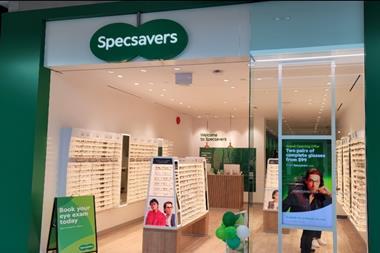With the fate of many UK high streets hanging in the balance, Mark Faithfull looks at five very different towns that are striving to prove there is still a place for local shopping — Derby, Rotherham, Morpeth, Plymouth and Ludlow
The pressures threatening to engulf the UK’s high streets have brought the future of many into sharp relief, but there are strategies for revival despite the structural challenges of coordinating a cohesive response.
“The first question for any high street to answer is: ‘Why would you go there?’,” says Matthew Hopkinson, business development director of The Local Data Company. “You need a unique offer, be that a value offer of Poundland and 99p Stores or somewhere like Market Harborough where people want the deli, the butcher, the local fashion shop and a decent florist.”
Bill Boler, director of investment and physical regeneration at Business in the Community, adds: “A clear idea of what you are trying to achieve is crucial, otherwise competing interests may come to different conclusions. Are you trying to preserve small businesses or increase footfall? The solution may not be same.”
Boler took a lead role in a retail-led regeneration of Harlem and is a champion of active decision-making about which local businesses merit support. “In Harlem we identified retailers that were community anchors, employed local people and provided real community services, and did all we could to help. Those just there for the money were left to market forces.”
Boler stresses: “You only need to wander a local high street and speak to people, or spend half an hour in the local pub to get a feel for those community anchors.”
Hopkinson adds: “Town centre managers need to look at the retail mix and not ignore a problem just because that means doing something about it.”
Derby: Retaining Catchment Spend
Starting point Derby competes with Nottingham and Leicester, plus Birmingham. Westfield Derby opened in 2007.
To build on Derby’s high-tech workforce has an average annual salary of about £30,000 and an attractive Cathedral Quarter.
Strategy “The big picture for Derby is building market share - wealth retention if you like,” says John Forkin, director of Marketing Derby, responsible for inward investment.
In 2006, before Westfield Derby opened, residents of the affluent suburbs between 15 to 30 minutes from Derby spent only 15p in the pound within the city. Westfield Derby shot the city’s annual retail spend up from £400m in 2006 to £680m last year and moved Derby from 63rd to 31st on the retail league table, while 30p in the suburban pound now stays put.
“Westfield’s arrival also created an enormous challenge, especially as it coincided with the start of the recession, which meant relocations and closures on the high street,” says Forkin.
The council introduced a strategy to try and spread the extra visitors and new wealth across the city and the first phase was to support the Cathedral Quarter. Derby set up a Business Improvement District to support a shop base of independent-run units.
“We have done a lot of branding and identity work and there are signs that more upscale independents have been drawn in, alongside Bang & Olufsen and Aga. We largely dealt with local landlords, agents and retailers, which helped with liaison.”
With Westfield in the south and the Cathedral Quarter in the north, an improved link was needed through the tired St Peter’s high street, where voids have risen to 14%.
“Here we found absentee landlords, mostly funds and generally with national agents,” says Forkin. “So we commissioned research by CACI to demonstrate the spending power of the catchment and we have attended events to raise our profile.
“We offer free primary research and local knowledge - for example, with one site we were able to point out that a new £50m bus station is due to open close by. We might be a dot on the radar from London, but our job is to make sure we get noticed.”
Rotherham: Creating the Right Environment
Situation Rotherham competes with Leeds and Sheffield plus Meadowhall. Voids and a tired environment needed to be addressed.
To build on Rotherham has a strong market reputation, while long-established independent retailers, such as a jewellers, have created a loyal customer base.
Strategy “A couple of years ago we decided we needed to address the vacant units in Rotherham and to develop the town with an independent, niche retail offer in contrast to nearby shopping centres like Meadowhall,” says town centre development manager Alison Hall. “The vacant units tended to be the smaller retail units that were more suitable for independents anyway.”
Things came to a head when the recession hit. “We recognised that this was the sort of time entrepreneurs spring up,” reflects Hall. “It also fitted with our other initiatives. We have a strong events programme and we have been encouraging residential development, so that people live, work and relax in the city.”
One of the first issues was to spruce up the environment, not only for shoppers but to give retailers confidence. Feedback showed that more planting and supporting the markets were people’s priorities, while financial assistance was offered for cafes to add outdoor seating.
“By offering financial support to start-up retailers we attracted more than a hundred applicants and the first two are open, with four more going through the process. It spurred a lot of interest,” says Hall. “We are also refurbishing a Grade II renaissance-style shopping gallery, which includes our new womenswear retailer, a cafe and the local arts community as a destination.”
Hall adds of national chains: “We hope we have shown we are moving Rotherham in the right direction and that we are proactive and prepared to work with them.”
Morpeth: Integrating New Development
Situation Morpeth was a successful market town but piecemeal development had broken up its retail offer.
To build on An ageing arcade offered potential as the link between the fragmented retailing.
Strategy “Development in most mid-sized towns tends to reflect knee-jerk reactions,” says Dransfield Developments managing director Mark Dransfield. “So when we looked at refurbishing the centre it was clear we needed to co-join the car parks and move the bus station, with the centre as the gateway between the car parks, a supermarket and the town.”
Dransfield points out that traditional high streets tend to lack the 1,000 sq ft and above stores that chain retailers are usually looking for. “Every destination needs an anchor and we were able to do a deal with Marks & Spencer to relocate from its constrained Simply Food store to a larger, full offer unit in the centre. That helped us to attract other national retailers,” he says.
Dransfield modelled his approach for Sanderson Arcade on London’s Burlington Arcade, with high-quality architecture, dark mahogany store fronts, sophisticated signage and retention of the 1920s facade on the town centre side.
“We also really liked the Burlington Beadles, who act as help and security, so we took that idea,” says Dransfield. “We dressed them from the Mayfair uniform manufacturer for Claridge’s and the Beadles have become something of a tourist attraction.”
Sanderson Arcade opened in November and Dransfield recommends community engagement. “We had to manage the decline of the centre as we moved towards possession but we worked with the local community and the local authority,” he recalls. “If you listen to constructive feedback then you will be helped when you have challenges like the one or two landlords who will always act as an obstacle to try and extract the best price.”
Plymouth: Repositioning a City

Situation
Ageing Plymouth used a Business Improvement District (BID) process to invigorate its city centre, which recently won a five-year extension.
To build on With more than 520 shops and a new shopping mall, Plymouth is the primary retail destination in the region.
Strategy Plymouth aims to become “one of Europe’s finest, most vibrant waterfront cities”, and a BID was introduced to help modernise the centre.
Investment in public realm space, better links between shopping districts and the opening of Drake Circus have all followed. Plymouth’s main retail offer is now divided between Armada Way, the city’s main pedestrian boulevard link from the station to the Hoe and waterfront; pedestrianised New George Street and Cornwall Street, which include high street brands and three major department stores; the Independent Quarter at the western end of the city centre; and Drake Circus, which opened in October.
Proposed projects include a £3.2m investment in the public realm in the west end of the city and £750,000 in car park improvements, while the council plans to grow Plymouth’s population by more than 50,000 by 2030.
The BID is delivered through Plymouth City Centre Company. Its primary purpose is to drive retail trading performance and the Plymouth BID has leveraged £5 of match-funding for every £1 of BID levy raised from businesses in the BID area. In an autumn vote more than 89% of retailers backed continuation of the BID for the next five years.
Plymouth City Centre Company chairman Duncan Currall says: “We have delivered a real step change in the trading environment and more than £10m of investment in our first five years. The BID projects will directly deliver £5m investment in the city centre over the next five years, unlocking millions of pounds of additional consumer spending, while also reducing business trading costs.”
Ludlow: Food-Based Niche

Situation
After fostering a food festival during the 1960s, market town Ludlow went into decline and, symbolically some might say, Tesco replaced the cattle market.
Tobuild on Attractive Ludlow had a strong independent retail scene and a food heritage.
Strategy The consensus was that the arrival of the first Tesco would destroy Ludlow’s lively town centre - particularly food producers like butchers, bakers and greengrocers, recalls Chris Bayliss, markets and special projects manager for Ludlow council.
As a remedy the Ludlow Food Festival was revived to enhance Ludlow’s reputation for local produce and the traditional market town environment.
“This roughly coincided with the arrival in town of celebrity chefs and in the early 2000s the Slow Food organisation made Ludlow its headquarters, which pre-empted the arrival of the Cittaslow organisation,” he says.
The Food Centre opened in 2007, offering units for artisan producers and retail shops on the same site. “Where it fails is in not being in or near the town centre and as such pulling trade away from existing retailers and tempting new independents,” says Bayliss. “Pulling together hasn’t been conspicuous; pulling alongside and in competition, yes.”
However, Bayliss says individuals with enterprise made things happen at a time when food was being re-evaluated and Cittaslow came close to bringing the various organisations together. “We are currently starting a new organisation called the Ludlow Community Trust (LCT), which will have buy-in from everyone and has the purpose of supporting the independent retail sector in Ludlow,” says Bayliss.
He stresses that LCT is still in its infancy but that previous lessons have been learned. Bayliss reflects that bringing all the private and public bodies together is vital.
He adds: “Strategic drift is a killer, personal agendas must not be allowed and the only thing the strategy must alter for is changes in the environment it is being delivered in.”



























2 Readers' comments